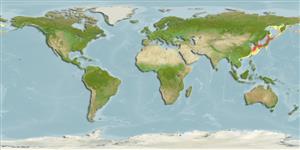Environment: milieu / climate zone / depth range / distribution range
Écologie
marin démersal; profondeur 20 - 269 m (Ref. 27311). Temperate
Northwest Pacific: northern Japan, Peter the Great Bay, and eastern coast of the Korean Peninsula.
Taille / Poids / Âge
Maturity: Lm ? range ? - ? cm
Max length : 50.0 cm TL mâle / non sexé; (Ref. 56557)
Description synthétique
Morphologie | Morphométrie
Épines dorsales (Total): 8 - 10; Rayons mous dorsaux (Total): 12-14; Épines anales 0; Rayons mous anaux: 8 - 12. Snout pointed, with 10 or more barbels on its ventral surface. No well-developed strong keel on side of the head. Branchial membranes united to isthmus. In addition to these characteristics, it differs from other agonids in having 11 or more dorsal fin rays, and 13 or more anal fin rays.
Common on muddy sand bottoms in 150 m or less. Adults feed on crustaceans and marine worms (Ref. 28197).
Life cycle and mating behavior
Maturité | Reproduction | Frai | Œufs | Fécondité | Larves
Mature females are multiple spawners (Ref. 32372).
Masuda, H., K. Amaoka, C. Araga, T. Uyeno and T. Yoshino, 1984. The fishes of the Japanese Archipelago. Vol. 1. Tokai University Press, Tokyo, Japan. 437 p. (text). (Ref. 559)
Statut dans la liste rouge de l'IUCN (Ref. 130435)
Menace pour l'homme
Harmless
Utilisations par l'homme
Plus d'informations
Taille/ÂgeCroissanceLongueur-poidsLongueur-longueurFréquences de longueursMorphométrieMorphologieLarvesDynamique des populations larvairesRecrutementAbondanceBRUVS
RéférencesAquacultureProfil d'aquacultureSouchesGénétiqueElectrophoresesHéritabilitéPathologiesTraitementNutrientsMass conversion
CollaborateursImagesStamps, Coins Misc.SonsCiguateraVitesseType de nageSurface branchialeOtolithesCerveauxVision
Outils
Articles particuliers
Télécharger en XML
Sources Internet
Estimates based on models
Preferred temperature (Ref.
123201): 1 - 18.4, mean 13.8 °C (based on 141 cells).
Phylogenetic diversity index (Ref.
82804): PD
50 = 0.5312 [Uniqueness, from 0.5 = low to 2.0 = high].
Bayesian length-weight: a=0.00389 (0.00180 - 0.00842), b=3.12 (2.94 - 3.30), in cm total length, based on all LWR estimates for this body shape (Ref.
93245).
Niveau trophique (Ref.
69278): 3.3 ±0.40 se; based on food items.
Résilience (Ref.
120179): Faible, temps minimum de doublement de population : 4,5 à 14 années (Preliminary K or Fecundity.).
Fishing Vulnerability (Ref.
59153): Moderate vulnerability (40 of 100).
